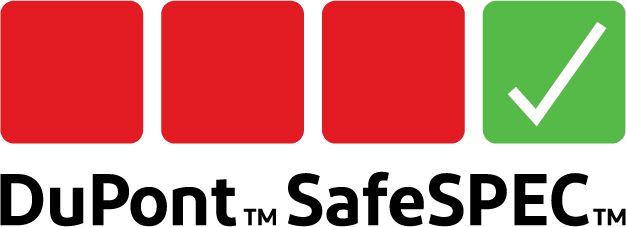A day at the burn center
By Jian Xiang, Global Technology Leader in Emergency Response Service,
DuPont Personal Protection

Skin keeps us hydrated; cools us when we sweat; and protects us from bacteria. Without skin, we are vulnerable to life-threatening infections and dehydration. Skin damage due to burns is one of the most traumatic injuries that a person can experience. It not only leaves an ineradicable scar, it also causes a physical, emotional and financial setback to a person’s life, regardless of age, gender or social background. A significant burn that covers 50% or more of the body’s surface area puts a person at a high risk of infection and death, especially if the person is elderly.
To better understand how burned patients are treated and cared for, a group of 12 scientists and engineers from DuPont Personal Protection recently visited the Evans-Haynes Burn Center at the VCU Medical Center in Richmond, Virginia. The Burn Center, founded by Dr. Evans in 1947 and later directed by Dr. Haynes, is the oldest civilian burn facility in the United States. The Center is the regional resource for the care of acute burns and reconstructive needs of burn survivors. It treats 400 to 450 pediatric and adult patients each year, accounting for 10% of all the Center’s trauma events.
According to Lillie Willis, coordinator of the outreach program, the Center treated 32 victims transferred from 9/11 Ground Zero and four victims from the Boston Marathon bombing. The Center’s state-of-the-art equipment and rehabilitation care have facilitated the treatment and restoration of thousands of lives affected by fire, scalds, chemical or electrical burns, and skin loss injuries.
Although advanced technologies make it possible to grow new skin that is one hundred times the size of a patient’s skin sample (which has resulted in a massive reduction in the mortality rate for patients with up to 95% body burn), victims may still require multiple procedures to heal and restore their bodies.
Physicians, scientists and engineers all agree that workers and individuals should always wear proper and functional personal protective equipment (PPE) whenever they are in an environment where they may be exposed to fire, high-voltage electricity, sharp objects, chemicals and other hazards.
Hand protection—sorting through the myriad requirements
Part 1 of 2 – Chemical hazards
Michael Sieber, Tychem® Gloves Technical Specialist,
DuPont Personal Protection

Safety managers and associated decision makers have many things to consider when conducting risk or hazard assessments and selecting personal protective equipment (PPE) for their workforce. The priority is to maintain worker safety. A major challenge is the fact that there are numerous PPE providers in the market, and not all PPE providers substantiate protection claims using the same standards or methods. In terms of chemical protective clothing (CPC), having hand protection match other CPC ensemble protection requirements is critical to maximize safety and comfort.
It is critical to identify the potential hazards of a given procedure, whether they are chemical and/or other types of hazards, such as mechanical (e.g., cut, puncture) or thermal (e.g., flame, contact, arc). This is typically accomplished through a job hazard assessment, which is mandated in the United States by the Occupational Safety & Health Administration (OSHA). Following identification of hazards, the next step is to determine which standards apply to the task, which often determines product selection and compatibility with other PPE.
In terms of chemical hand protection, there are three major ways that a material’s chemical resistance can be measured:
1. The crudest method is degradation, which provides an indication as to what the expected physical change of the glove should be. Degradation shouldn’t be confused with the actual time it takes for the chemical to break through the glove. It is important to understand that degradation is not a measure of barrier; it is simply a means of assessing the compatibility of the material after contact with a chemical. Degradation is determined to have occurred when there is a noticeable change in the material being tested. This can be assessed via either subjective visual assessment (i.e., to observe swelling, stiffening or becoming brittle) or quantitative measurement (i.e., puncture strength loss or potentially weight loss).
Chemical degradation resistance can be referenced using ANSI/ISEA 105:2016 in the United States or using EN ISO 374- 4:2016 internationally. Both requirements are essentially identical because they look at puncture strength loss before and after chemical exposure.
2. Penetration occurs when a selected challenge can pass through pores or orifices in a given medium. With respect to gloves, coated or fully dipped gloves declared as impermeable are evaluated for air and water leakage as they are inspected by manufacturers during quality control (QC) testing. This is typically evaluated via the glove being filled with, or immersed in, pressurized air or water, respectively. There are also standardized methods that can be used for testing outside of QC. In the United States, ANSI/ISEA 105 for penetration references a test for chemical penetration under pressure exposure testing. In the EU and internationally, EN ISO 374- 2:2014 can be referenced for penetration to air and water.
A subcategory of penetration is penetration against bloodborne pathogens or microorganisms, or viral penetration. These test methods include penetration versus blood and a simulant bacteriophage (or virus). In the United States, ISEA 105 only refers to viral penetration using ASTM F1670. Internationally, EN ISO 374-5:2016 sets two levels of requirements for bacteria and fungi using the requirements of EN ISO 374-2:2014 and additionally for virus using the requirements of ISO 16604.
3. The third and most sensitive chemical protection mode is permeation, which directly measures the permeability to a liquid or vapor challenge of a specific chemical or mixture of chemicals of interest. Depending on the method and source, permeation data can be reported in the form of a time, rate or mass-based value. Actual breakthrough time, normalized breakthrough time, minimum detectable permeation rate, steady state permeation rate or cumulative permeation are a non-exhaustive list of breakthrough criteria. Breakthrough criteria definitions can provide significantly different values if one is mistaken for the other. For instance, a breakthrough criterion of 1.0 μg/cm2/min might yield a higher breakthrough time than 0.1 μg/cm2/min; even though these could be the same chemical challenge and the same sample specimen, it should be noted that the chemical’s breakthrough time is being measured at different rates and must be interpreted accordingly. It is important to keep in mind that following any chemical exposure, the chemical on the glove will continue to permeate even after direct contact has ended.
The primary permeation test method used to assess industrial chemical hazards for gloves in the United States is ASTM F739; internationally it is EN 16523-1 (used under EN ISO 374-1:2016). The main difference between these test methods is that ASTM F739 uses a test temperature of 27°C and a breakthrough criterion of 0.1 μg/cm2/min while EN 16523-1 uses a test temperature of 23°C and a breakthrough criterion of 1.0 μg/cm2/min. In addition, the EN ISO standard specifically requires testing from a predetermined list of 18 chemicals (indicated by a letter code), as well as listing the breakthrough time against the respective chemicals via ordinal levels of performance (0–6, ascending protection) on the label.
The primary difference between swatch level garment testing and glove testing is that gloves are also tested for intermittent contact. Intermittent contact permeation methods, such as ASTM F1383, can be a more relevant or representative evaluation for materials that might come into contact with chemical hazards for a shorter or otherwise intermittent period of time. The intermittent permeation method uses the same testing conditions and apparatus as the constant contact permeation test, but for different time intervals. Currently, only ASTM F1383 and ISO 6529 methods are used for intermittent permeation testing.
In part 2 of this article, which will be published in the next issue of The Glow Worm, we will discuss how to address hand protection with respect to mechanical hazards, such as cut, puncture, tear, impact and abrasion resistance, along with electrical discharge and thermal (arc, flame, hot or cold contact) hazards. To view the DuPont line of chemical gloves with chemical permeation results, please visit safespec.dupont.com.
PPE presentation at the Harvard T.H. Chan School of Public Health’s Comprehensive Industrial Hygiene Seminar
By Corey Briggs,CIH, CET, FAIHA, & Distinguished Lecturer of
the American Industrial Hygiene Association; Senior Consultant, Colden Corporation – New England Regional Office colden.com

For the fourth consecutive year, I presented the “Personal Protective Equipment and Clothing” session at the annual Harvard T.H. Chan School of Public Health’s Comprehensive Industrial Hygiene Seminar. During this week-long, in-depth program, 39 public and private sector Environment, Health & Safety (EHS) professionals from many countries around the globe, including Australia, Ghana, Mongolia and Mali, attended my highly interactive lecture and demonstration.
Using a collection of personal protective equipment (PPE) that I’ve collected for more than 30 years, I provided information on the basics of PPE (e.g., head-to-toe protection; various elastomerics; disposable laminates; permeation; sizing; pluses and drawbacks; durability; heat stress; etc.) and showed recent PPE advances such as the DuPont™ Tychem® 2000 SFR garment, DuPont™ Tyvek® 400 HV high-visibility coverall and Tychem® 6000 coveralls, including TF611T, which is a unique rear-entry chemical protective suit with an elastomeric interface hood that seals around full facepiece respirators.
Attendees learned about all types of PPE, from day-to-day industrial uses to the highest level of hazmat response. During the session, I also discussed the DuPont™ SafeSPEC™ online selector tool.
I would like to extend special thanks to Rachel Werkman, Lou DiBeradinis and the entire team at the Center for Executive and Continuing Professional Education at the Harvard T.H. Chan School of Public Health for putting on a great seminar for the weeklong intensive review of industrial hygiene. To learn more about this program, please visit https://www.hsph.harvard.edu/ecpe/ programs/comprehensive-industrial-hygiene/.
Hazmat through history: Fire departments
By Daniel Hammel, Marketing Consultant,
DuPont Personal Protection

The brave men and women who serve as firefighters help their communities in many ways. Beyond working to extinguish fires, firefighters respond to medical emergencies and hazmat incidents, and they lead investigations, audits and training aimed at fire prevention. Fire departments in many large cities now have special hazmat units to respond to local incidents.
Although hazmat responses remain a relatively low percentage of total responses by a fire department (medical assistance is the most common, followed by false alarms and actual fires, respectively), a hazmat call can pose a huge threat to the health and safety of a firefighter.
Although there was some rudimentary organized firefighting dating back to third century BC in ancient Egypt, the earliest fire department arose in Rome circa 50 BC. Marcus Licinius Crassus privately organized about 500 men to respond to fires in the ancient city. However, Crassus’ intentions were less than noble. His brigade was not formed in the interest of public safety, but instead was designed to provide him with great wealth through exploiting people in a time of severe need. When a building caught fire, Crassus’ team would arrive, but instead of first extinguishing the fire, Crassus would make an extremely meager offer to buy the property. If the owner refused, the fire would rage on without any of the brigade’s assistance. If the owner agreed to the sale, Crassus would authorize his team to fight the fire. If they were successful in extinguishing the fire, Crassus would enjoy great profits thanks to the misfortune of the previous owner.
Fire departments continued to be privately held for hundreds of years, but eventually the need for public fire departments became apparent. In the United States, Boston created the first publicly funded fire department in 1678. But it wasn’t until 1853 in Cincinnati that a U.S. city had a fire department consisting fully of paid firefighters.
One tradition that was picked up along the way is the use of Dalmatians as a mascot for fire departments. This dates back to the 1700s when fire departments used carriages that were drawn by horses. Understandably, horses would get spooked by the sight of the blaze, and having Dalmatians nearby would calm and distract them. The dogs would also run alongside the horses on the way to the scene, alerting passersby that the firefighters were coming through, with their barking serving as an early type of siren. Although Dalmatians aren’t needed to serve these roles today, they are still popularly known as a fire department icon.
Products and/or sales questions?
Share your stories, tips and tricks.

Resource library
Find technical information, videos, webinars and case studies about DuPont PPE here.


